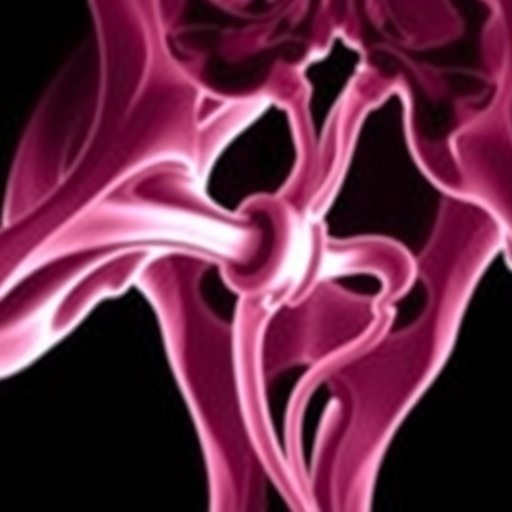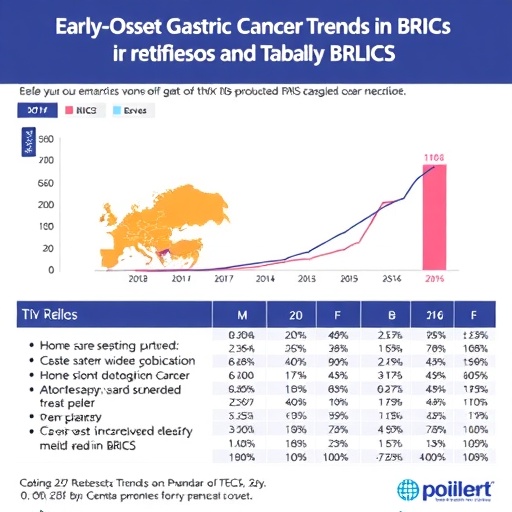In the rapidly advancing field of gynecologic oncology, a groundbreaking study has illuminated the pivotal role of endocervical curettage (ECC) in the early detection of high-grade cervical intraepithelial neoplasia (CIN2+) among postmenopausal women persistently infected with high-risk human papillomavirus (hrHPV). This new research, published in BMC Cancer, delves into the nuanced interplay between viral genotypes, cytological abnormalities, and the anatomical complexity presented by transformation zone type 3 (TZ3), unraveling diagnostic intricacies that could reshape clinical approaches.
Cervical cancer screening and diagnosis have long relied on the triad of hrHPV detection, cytology, and colposcopy, but challenges persist, particularly in postmenopausal populations where the transformation zone—the transition area between squamous and columnar epithelium—often recedes into the endocervical canal, categorized as TZ3. This anatomical shift complicates lesion visualization and sampling, raising concerns about missed diagnoses. The current investigation scrutinizes ECC’s effectiveness in augmenting detection rates of CIN2+ lesions in this challenging demographic.
The authors conducted a retrospective observational analysis encompassing 137 HPV-positive postmenopausal women undergoing colposcopy with concurrent ECC and subsequent Loop Electrosurgical Excision Procedure (LEEP). This robust dataset allowed for rigorous evaluation of variables including HPV genotype differentiation (HPV 16/18 versus non-16/18), cytological gradations, transformation zone characterization, and age stratifications, all correlated against histopathological outcomes post-LEEP serving as the diagnostic gold standard.
Intriguingly, the study reveals an overall CIN2+ prevalence of 27.7%, with nearly one-fifth (19%) exhibiting CIN3 or worse, underscoring the persistence of significant neoplastic risk even post-menopause. Multivariable logistic regression surfaced high-grade cytological findings as the most potent predictor of CIN2+, exhibiting an adjusted odds ratio (aOR) of 4.65, an association with compelling statistical significance. These findings reinforce the enduring importance of cytology despite emerging molecular techniques.
Moreover, the presence of a TZ3 independently predicted increased CIN2+ risk (aOR 3.05), validating clinical suspicions that transformation zone type affects lesion detectability and disease burden in this population. This anatomical factor thus commands heightened attention during colposcopic evaluation and biopsy strategy formulation, particularly since lesions residing within the endocervical canal evade direct visualization.
Counterintuitively, the study found that non-16/18 hrHPV genotypes were associated with a higher absolute risk of CIN2+ (36.8%) compared to the traditionally oncogenic HPV16/18 strains (16.4%). This observation challenges prevailing paradigms that prioritize HPV16/18 in risk stratification and may provoke reconsideration of genotype-specific surveillance and management guidelines for postmenopausal women.
Age—often considered a key variable in oncogenic risk profiling—did not yield statistical significance in predicting CIN2+ when controlled for other factors (aOR 1.28, p=0.55), suggesting that chronological aging alone is less influential than cytological and virological markers in this specific cohort.
ECC emerged as a valuable diagnostic adjunct, exhibiting a sensitivity of 73.7% and specificity of 77.8% for CIN2+ detection, alongside a noteworthy negative predictive value (NPV) of 88.5%. The high NPV signals ECC’s strength as a rule-out modality, enabling clinicians to confidently exclude significant neoplasia in certain patients, which may spare them from more invasive interventions.
The study advocates for the consideration of expedited diagnostic and therapeutic LEEP in cases where high-grade cytology (notably ASC-H or HSIL) coincides with a TZ3, especially in women past childbearing desire. Such prompt intervention may mitigate progression risks and optimize clinical outcomes, balancing the invasive nature of LEEP against its diagnostic and therapeutic efficacy.
These findings collectively emphasize a multifactorial assessment framework where HPV genotype, cytology grade, and TZ type collectively inform risk stratification and management in postmenopausal women with persistent hrHPV infection—a population historically underrepresented in cervical cancer prevention research.
Beyond clinical insights, the study ignites discourse on the evolution of screening strategies, suggesting that reliance on HPV16/18-centric algorithms may overlook a substantial subset with non-16/18-driven neoplasia, necessitating nuanced guidelines that incorporate broader genotype panels and adjunctive sampling techniques such as ECC.
The implications extend to public health realms, where strategic deployment of ECC could enhance early detection capabilities in postmenopausal women—a demographic often exhibiting diagnostic ambiguities due to anatomical and hormonal changes—with potential to reduce cervical cancer morbidity and mortality through tailored surveillance.
Crucially, the research team calls for expansive multicenter cohort studies to validate the association of non-16/18 genotypes with high-grade disease risk observed here, aiming to solidify evidence that may recalibrate risk models and tailor precision medicine approaches further.
In sum, this study sheds light on the integral role of ECC in revealing hidden neoplasia within the endocervical canal in postmenopausal women harboring persistent hrHPV infections, particularly against the backdrop of complex anatomical alterations encoded by TZ3. It underscores the necessity of integrating anatomic, virologic, and cytologic factors in comprehensive cervical cancer risk evaluation.
As the fight against cervical cancer transitions increasingly towards personalized medicine, findings such as these empower clinicians to refine diagnostic pathways, minimize missed diagnoses, and optimize therapeutic interventions, ultimately enhancing patient outcomes and quality of life.
This pioneering investigation represents a critical stride in the ongoing effort to demystify cervical carcinogenesis in postmenopausal women and exemplifies the integration of rigorous statistical modeling with clinical acumen, heralding a new horizon in oncologic diagnostics.
Subject of Research: The effectiveness of endocervical curettage (ECC) in detecting cervical intraepithelial neoplasia grade 2 or worse (CIN2+) among HPV-positive postmenopausal women with type 3 transformation zone (TZ3) and the identification of predictive risk factors.
Article Title: Role of endocervical curettage in detecting CIN2 + in postmenopausal women with persistent high-risk HPV and type 3 transformation zone.
Article References:
Bruno, M.T., Cavallaro, A.G., Sudano, M.C. et al. Role of endocervical curettage in detecting CIN2 + in postmenopausal women with persistent high-risk HPV and type 3 transformation zone. BMC Cancer 25, 1486 (2025). https://doi.org/10.1186/s12885-025-14868-5
Image Credits: Scienmag.com
DOI: https://doi.org/10.1186/s12885-025-14868-5
Tags: cervical cancer screening advancementsCIN2+ diagnosis in postmenopausal womencolposcopy and ECC effectivenesscytology and histopathology correlationdiagnostic complexities in postmenopausal populationsendocervical curettage for cervical cancer detectiongynecological cancerhigh-risk HPV and cervical intraepithelial neoplasiaHPV genotype differentiation in cervical lesionsLoop Electrosurgical Excision Procedure outcomesretrospective analysis in gynecologic oncologytransformation zone type 3 challenges





